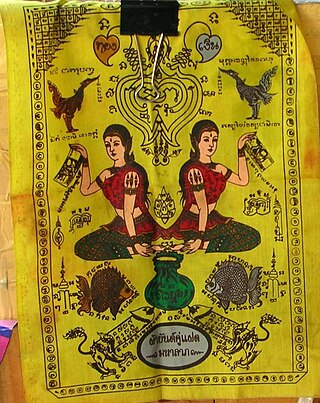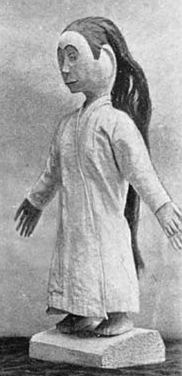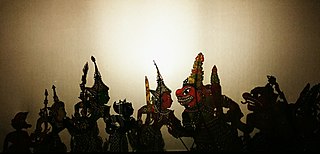Related Research Articles

The Kuntilanak, also called Pontianak, is a mythological creature in Indonesia, Malaysia and Singapore. It is similar to Langsuir in other Southeast Asia regions. The Pontianak usually takes the form of a pregnant woman who is unable to give birth to a child. Alternatively, it is often described as a vampiric, vengeful female spirit. Another form of the Pontianak refers to the ghost or white lady of Southeast Asian folklore.
A toyol or tuyul is an undead infant in Indonesian and Malay folklore. It also appears in the various other mythologies of Southeast Asia and is typically invoked as a helper by shamans by means of black magic. A common use for the toyol includes using it for financial gain, where the creature robs people of their riches, making it similar to the Babi ngepet, a boar demon in Indonesian mythology, and the Hantu Raya, a familiar spirit in Malay folklore. As such, the toyol is popularly known to bring good luck to its host, but mishap to those who are unfortunate to encounter them. The toyol as a biological specimen exists and it is associated with the toyol as a spirit.
Hantu may refer to:

Hantu is the Malay and Indonesian word for spirit or ghost, sometimes it is also the Tagalog word for ghost. In modern usage it generally means spirits of the dead but has also come to refer to any legendary invisible being, such as demons. In its traditional context the term also referred to animistic nature spirits or ancestral souls. The word is derived from Proto-Malayo-Polynesian *qanitu and Proto-Austronesian *qaNiCu. Cognates in other Austronesian languages include the Micronesian aniti, Lio language nitu, Yami anito, Taivoan alid, Seediq and Atayal utux, Bunun hanitu or hanidu, Polynesian aitu or atua, and Tsou hicu among the Formosan languages. In terms of concept and place in traditional folklore, it is most similar to the Filipino anito.
The penanggal or penanggalan is a nocturnal vampiric entity from Malay ghost myths. Its name comes from the word tanggal meaning to remove or take off, because its form is that of a floating disembodied woman's head with its trailing organs still attached. From afar, it twinkles like a ball of flame, providing an explanation for the will-o'-the-wisp phenomenon.

There are many Malay ghost myths, remnants of old animist beliefs that have been shaped by Hindu-Buddhist cosmology and later Muslim influences, in the modern states of Brunei, Indonesia, Malaysia, Singapore and among the Malay diaspora in neighbouring Southeast Asian countries. The general word for ghost is hantu, of which there exist a wide variety. Some ghost concepts such as the female vampires pontianak and penanggal are shared throughout the region. While traditional belief doesn't consider all ghosts as necessarily evil, Malaysian popular culture tends to categorise them all as types of evil djinn.
Pelesit is a type of familiar spirit in Malay folklore. It is generally a cricket, or occasionally a grasshopper. The term literally means "buzzer" from the root word lesit meaning to buzz or whizz, as an insect does. They are also called Palasik.
The polong is a type of familiar spirit in Malay folklore. It has the appearance of a miniature woman, the size of the first joint of the finger.
Hantu Air, Puaka Air or Mambang Air is the Malay translation for Spirit of the Water or Water Ghost, which according to animist traditions in Maritime Southeast Asia, is the unseen inhabitant of watery places such as rivers, lakes, seas, swamps and even ditches. Communication between humans and Hantu Air occur in situations based on the well-being of an environment and can be positive or negative. Water spirits are called on and communicated with through ceremonies, rituals, incantations, and in extreme cases exorcisms. Hantu Air is associated with bad things happening to people including missing persons, drowning, flooding and many other incidents.
The Tajul muluk is common used name for the system of geomancy, comprising metaphysical and geomantic principles considered when siting or designing buildings to improve and maintain well-being in Maritime Southeast Asia. It was traditionally practiced by shamans and architects from Indonesia and Malaysia. The term actually alludes to a book entitled Tajul muluk which covered a number of other topics including herbal medicine, astrology and dream interpretation along with geomancy. While all these subjects may be categorised under the term ilmu tajul, it usually refers to the otherwise unnamed set of rites and rules for constructing buildings in Acehnese and Malay culture.

Malay folklore refers to a series of knowledge, traditions and taboos that have been passed down through many generations in oral, written and symbolic forms among the indigenous populations of Maritime Southeast Asia (Nusantara). They include among others, themes and subject matter related to the indigenous knowledge of the ethnic Malays and related ethnic groups within the region.
Carol Laderman was a groundbreaking medical anthropologist, specializing in the study of pregnancy and childbirth practices, shamanism, and Southeast Asian cultures, particularly Malays in rural Terengganu, Malaysia. She was also a critically acclaimed writer and a longtime professor and lecturer who had just been re-elevated to Chairmanship of the Department of Anthropology at City College at the time of her death.

The mythology of Indonesia is very diverse, the Indonesian people consisting of hundreds of ethnic groups, each with their own myths and legends that explain the origin of their people, the tales of their ancestors and the demons or deities in their belief systems. The tendency to syncretize by overlying older traditions with newer foreign ideas has occurred. For example, the older ancestral mythology might be merged with foreign mythology, such as Hindu, Islam, or Christian biblical mythology.

Thai folklore is a diverse set of mythology and traditional beliefs held by the Thai people. Most Thai folklore has a regional background for it originated in rural Thailand. With the passing of time, and through the influence of the media, large parts of Thai folklore have become interwoven with the wider popular Thai culture.

Belief in ghosts in Thai culture is both popular and enduring. In the history of Thailand, Buddhist popular beliefs intermingled with legends of spirits or ghosts of local folklore. These myths have survived and evolved, having been adapted to the modern media, such as Thai films, Thai television soap operas, and Thai comics.
Hantu Tinggi is a being similar to 'Hantu Raya' or 'genderuwo' but so tall its body from the waist up is hidden by clouds. It only exists in the Western and Eastern regions of Malaysia. In Thailand, Hantu Tinggi likely resembles a closer myth called Preta.

The langsuyar, also lang suir or langsuir, is a female revenant in Malay and other mythologies in the Malay archipelago. The word is derived from the Malay word for eagle (helang).

Malaysian folklore is the folk culture of Malaysia and other indigenous people of the Malay archipelago as expressed in its oral traditions, written manuscripts and local wisdoms. Malaysian folklores were traditionally transmitted orally in the absence of writing systems. Oral tradition thrived among the Malays, but continues to survive among Orang Asli and numerous bornean ethnic groups in Sarawak and Sabah. Nevertheless, Malaysian folklores are closely connected with classical Malay folklore of the region. Even though, Malay folklore tends to have a regional background, with the passing of time, and through the influence of the modern media, large parts of regional Malay folklore have become interwoven with the wider popular Malaysian folklore.
References
- ↑ Wives and Midwives: Childbirth and Nutrition in Rural Malaysia, By Carol Laderman
- ↑ Malay magic: an introduction to the folklore and popular religion of the ... By Walter William Skeat
- ↑ Taming the Wind of Desire: Psychology, Medicine, and Aesthetics in Malay... by Carol Laderman, "Taking Human Form".
- ↑ Demons, By Kris Hirschmann
- ↑ Wives and Midwives: Childbirth and Nutrition in Rural Malaysia By Carol Laderman
- ↑ My head's angol: hantu raya